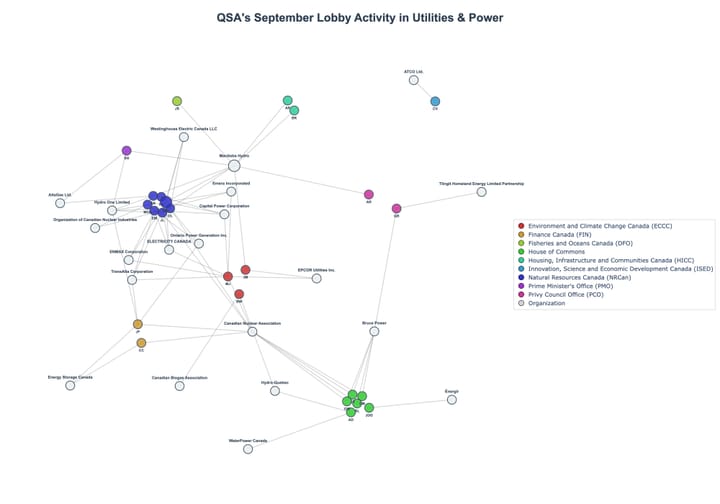QSA's Week in Utilities & Power (#45, 2025)
Canada commits $1T over 5 years for clean energy; New federal tax credits for grid upgrades, nuclear, storage; Toronto, Calgary, and Saint-Laurent echo climate competitiveness push; Major Projects Office reviews LNG, hydro, mining, and critical minerals projects; StatsCan: higher energy output an...

Good morning! This is Queen Street Analytics' weekly roundup of regulatory developments, legislative discussions, political announcements, and other government-related news concerning power generation and transmission, wind and solar, utilities, midstream companies, batteries and energy storage, LNG, biofuels and nuclear. Every Monday, we break down the most important updates in this space in under five minutes.
Want to track other GR news in adjacent industries? Don’t miss this week’s updates in Oil & Gas and Construction.
Dates: 2025-11-09 to 2025-11-15
📋 In This Week's Newsletter
• 🏛️ This Week's Parliamentary Calendar
• 🇨🇦 Canadian Federal Government News
• 🗺️ Canadian Provincial Government News
• 🇺🇸 US Federal Government News
• 💬 Government Consultations
• 📚 What We're Reading This Week
This Week's Parliamentary Calendar
- House Environment and Sustainable Development (ENVI): Electric Vehicle Availability Standard Study: On November 17, the ENVI committee will convene from 11:00 a.m. to 1:00 p.m. on the Electric Vehicle Availability Standard. Witnesses: Association des véhicules électriques du Québec (Sébastien Côté), Canadian Automobile Dealers Association (Tim Reuss), Canadian Charging Infrastructure Council (Travis Allan), Canadian Vehicle Manufacturers' Association (Brian Kingston), Greenpeace Canada (Keith Stewart), and Propulsion Québec (Stéphane Pascalon). Location: Room 410, Wellington Building, Ottawa.
- Senate Standing Committee on Fisheries and Oceans: Ocean Carbon Sequestration: On November 18, the Fisheries and Oceans Committee will hear from witnesses including Natural Resources Canada, Environment and Climate Change Canada, Fisheries and Oceans Canada, and Treasury Board Secretariat on ocean carbon sequestration at 6:30 p.m., Room W110, 1 Wellington.
- Senate Standing Committee on Energy, the Environment and Natural Resources: Newfoundland and Labrador Offshore Petroleum Industry: The Senate Energy, Environment and Natural Resources Committee meets November 18, 6:30 p.m., Room B30, to examine Newfoundland and Labrador's offshore oil and gas sector. Witnesses: Carleton University, Memorial University, Enaimco, and Wade Locke.
- Senate Standing Committee on Energy, Environment and Natural Resources: Newfoundland and Labrador Offshore Petroleum—Industry Stakeholders: November 20, 8:00 a.m., Senate of Canada B30, the committee will hear from Fish, Food and Allied Workers Union, Canadian Association of Petroleum Producers, and Trades NL regarding the offshore sector.
Canadian Federal Government News
Budget 2025 Launches Climate Competitiveness Strategy With Major Clean Energy Investment Commitments
On November 9, Ministers Julie Dabrusin (Environment and Climate Change) and Tim Hodgson (Energy and Natural Resources) in Toronto provided details on the federal government's new Climate Competitiveness Strategy under Budget 2025. The plan allocates more than $1 trillion in investment over five years to scale nuclear, hydro, wind, energy storage, and grid infrastructure to boost Canada's status in the low-carbon economy. Key features include the introduction of a 15% Clean Electricity Investment Tax Credit—with eligibility expanded to Crown corporations, a broadened 30% Clean Technology Manufacturing Credit for critical minerals, extended Carbon Capture, Utilisation and Storage (CCUS) tax credits through 2035, and new tax credits for small nuclear and biogas systems. The government also aims to strengthen the industrial carbon pricing regime post-2030, work toward harmonized carbon markets, and apply a stricter federal carbon benchmark if provincial systems become non-compliant. Clarification and tightening of greenhouse gas and methane regulations for both oil, gas, and landfills are planned, alongside $2 billion in new funding for critical minerals over five years to support production and processing via a new Critical Minerals Sovereign Fund and the First and Last Mile Fund.
Sources: www.canada.ca

Climate Competitiveness Strategy Receives Multi-Region Cabinet Endorsements
On November 9, Ministers and parliamentary secretaries across Alberta, Quebec, British Columbia, Nova Scotia, and Ontario—Eleanor Olszewski, Marjorie Michel, Adam van Koeverden, Randeep Sarai, and Lena Metlege Diab—held events in Calgary, Saint-Laurent, Brampton, Burnaby, and Halifax pledging support for Budget 2025’s Climate Competitiveness Strategy. These officials reiterated the plan’s aims: bolstering industrial carbon pricing, streamlining greenhouse gas regulations, driving clean economy investment with targeted tax credits, backing critical minerals projects, and mobilizing capital for the net-zero transition.
Sources: www.canada.ca, www.canada.ca, www.canada.ca, www.canada.ca, www.canada.ca
Major Projects Office to Review LNG, Transmission, Mining, and Indigenous Clean Power Initiatives
On November 13 in Timmins, Minister Tim Hodgson (Energy and Natural Resources) announced the next group of projects to be referred to the federal Major Projects Office (MPO): Ksi Lisims LNG, North Coast Transmission Line, Northwest Critical Conservation Corridor, Sisson mine (tungsten), Iqaluit Nukkiksautiit Hydro (Nunavut), Nouveau Monde Graphite mine and battery materials plant (Quebec), and Canada Nickel’s Crawford Nickel mine (Ontario). Over half relate directly to critical minerals—including plans for nickel refining (with Indigenous equity partners), battery supply chains, and graphite processing. The MPO will coordinate permitting for over $55 billion in new investment, aiming to fast-track “nation-building” infrastructure across resource, energy, and grid developments. The projects also include Nunavut's first 100% Inuit-owned hydro facility and Indigenous investments in mining. Hodgson underscored plans for an additional $2 billion Critical Minerals Sovereign Fund, a First and Last Mile Fund, and a Defence Industrial Strategy commitment for mineral processing and stockpiling capabilities.
Sources: www.canada.ca
Canada Nickel's Crawford Project Advances as Part of MPO Critical Mineral Strategy
On November 13, Minister Tim Hodgson visited the Canada Nickel Company’s Crawford Project in Timmins as it joined the Major Projects Office’s accelerated review list. The nickel mine, with an expected 40-year operation, aims to produce battery-grade, low-emission nickel and eventually refine iron, cobalt, platinum, palladium, and chromium. The project estimates carbon emissions at 90% below the global industry average, projecting a net-negative carbon footprint. Its further expansion would include development of a nickel refinery and stainless/alloy steel production targeting the automotive and battery sectors. Indigenous equity partnerships and $5 billion expected in investment support a projected 4,000 new jobs tied to critical minerals, clean steel, and battery supply chains. Funding from the Critical Minerals Infrastructure Fund backs the project’s strategic role under the federal critical minerals agenda.
Sources: www.canada.ca
Nunavut’s Iqaluit Nukkiksautiit Hydroelectric Project Joins Federal Major Projects List
On November 13, Minister Rebecca Alty (Crown-Indigenous Relations) visited the Iqaluit Nukkiksautiit Hydroelectric Project now referred to the Major Projects Office. Led by the Nunavut Nukkiksautiit Corporation, the facility is slated to replace diesel-based power generation in Iqaluit, targeting greater energy security, emission reductions, and local economic growth. The project will serve as Nunavut’s first fully Inuit-owned clean energy developer and is backed by prior investments from Northern REACHE and CanNor. Following referral, it will be part of a new tranche of projects representing $55 billion in investment with objectives to build Arctic energy sovereignty and facilitate community-led clean power.
Sources: www.canada.ca
Federal Support for Grid Modernization and Manufacturing in Quebec’s Electricity Sector
On November 13, Canada Economic Development for Quebec Regions (CED) announced a $600,000 repayable contribution to Sicame Énergie Inc. in Longueuil to support acquisition of digital production equipment. The investment is intended to automate operations, develop new products, and support the electricity transmission and distribution sector. Sicame Énergie designs and manufactures nearly 4,000 products for North American utilities. The funds, delivered under the Regional Economic Growth through Innovation program, support productivity, local supply chain integration, and equipment upgrades, aligning with CED and Quebec’s strategic support for manufacturing as 12.3% of provincial GDP and 86.1% of exports.
Sources: www.canada.ca
StatsCan: Higher Energy Use, Exports, and Pipeline-Driven Output in 2024
Statistics Canada reported on November 13 that domestic production, exports, and consumption of energy products all grew in 2024 compared to the prior year. The expanded Trans Mountain Pipeline, operational since May, fueled higher export volumes. Increased domestic energy demand was led by the mining, oil and gas extraction, and pipeline transportation subsectors. The data confirm upward trends in energy output and market activity for power generators, pipelines, and transmission operators.
Sources: www.statcan.gc.ca
Electric Power Selling Price Index, September 2025 Released
On November 10, Statistics Canada published its Electric Power Selling Price Index for September 2025, tracking wholesale electricity prices for Canadian utilities against a 2014=100 baseline. The latest release will inform utility sector benchmarking and pricing analysis for market participants.
Sources: www.statcan.gc.ca
Architectural, Engineering and Related Services Price Index, Q3 2025
Statistics Canada released third quarter 2025 data for its Architectural, Engineering and Related Services Price Index (2018=100) on November 14, supporting assessment of price trends in design and infrastructure engineering services—a key input for utilities, power developers, and grid expansion planning.
Sources: www.statcan.gc.ca
Provincial Input-Output Tables for 2022 Available
Provincial input-output tables for 2022 were released by Statistics Canada on November 13. These tables provide a comprehensive resource for utility operators, regulators, and policymakers tracking sectoral linkages, cost structures, and economic flows within and across provinces.
Sources: www.statcan.gc.ca
Canadian Provincial Government News
Ontario Begins Construction of Canada’s Largest Battery Storage Project
On November 12, ground broke in Edwardsburgh Cardinal on the Skyview 2 Battery Energy Storage System, which once operational in 2027 will have enough capacity to power 400,000 homes and increase Ontario’s energy storage fleet to nearly 3,000 MW. The project is developed by Potentia Renewables and the Algonquins of Pikwakanagan First Nation.
Sources: news.ontario.ca
Alberta Launches Methane Reduction Programs for Oil and Gas Sector
Alberta announced $29 million in funding for two new programs—the Methane Reduction Deployment Program and the Methane Reduction Demonstration Program—on November 12. These are aimed at helping energy producers deploy and test methane reduction technologies across Alberta, supported by Emissions Reduction Alberta and the NGIF Accelerator.
Sources: www.alberta.ca
Nova Scotia Adds New Tidal Energy Projects to Fundy Ocean Research Centre
On November 10, Eauclaire Tidal Limited Partnership secured two new berths at the Fundy Ocean Research Centre, adding up to 12.5 MW of tidal generation to the existing 4 MW in partnership with Orbital Marine Power. The projects receive tidal energy licenses and long-term power purchase agreements with Nova Scotia Power.
Sources: news.novascotia.ca
Ontario Announces $165 Million Biofuel Facility for Renewable Natural Gas
On November 14, the Ontario government and Convertus Group confirmed a $165 million investment to build a new facility in York Region to convert organic waste to renewable natural gas using CO2 liquefaction technology. Ontario is supporting the project with $2 million through the Advanced Manufacturing and Innovation Competitiveness stream.
Sources: news.ontario.ca
British Columbia Invests $241 Million to Expand Skilled Trades Training
The BC government on November 14 announced a three-year, $241 million fund to double trades-training capacity and expand certification across key industries, including clean energy and infrastructure, to support future major projects.
Sources: news.gov.bc.ca
US Federal Government News
EPA Approves Texas Class VI Carbon Sequestration Primacy
On November 14, the Environmental Protection Agency published a final rule granting the State of Texas primacy for permitting and enforcement of Class VI underground injection wells used for geologic carbon sequestration, excluding Indian lands. The Texas Railroad Commission will now oversee most Class VI CO2 storage wells, while EPA will continue as permitting authority for Class VI wells on Indian lands. The EPA’s assessment concluded Texas meets SDWA section 1422 and regulatory requirements for technical, financial, and legal oversight.
Sources: www.federalregister.gov
EPA Finalizes Hazardous Waste Combustor Emission Standards Update
On November 10, the EPA announced a proposed rule and withdrawal of a prior proposal for hazardous waste combustor (HWC) National Emission Standards for Hazardous Air Pollutants (NESHAP). New provisions include updated emission limits and work practice standards for hydrogen fluoride and hydrogen cyanide, elimination of the startup, shutdown, and malfunction exemption, changes to electronic reporting, permitting options for area sources, and clarified compliance procedures. The action, mandated under the Clean Air Act and by court order, is set for comment through December 26, 2025.
Sources: www.federalregister.gov
Phasedown of Hydrofluorocarbons—Comment Period Extended
On November 14, the EPA extended through November 21, 2025, the public comment period for its proposed rule reconsidering certain regulatory requirements related to the phasedown of hydrofluorocarbons under the American Innovation and Manufacturing Act. The extension follows stakeholder requests and seeks further industry feedback before finalization.
Sources: www.federalregister.gov
Utah Interstate Ozone Plan Approved for 2008 NAAQS
The EPA finalized on November 10 the approval of Utah’s State Implementation Plan addressing interstate transport of ozone for the 2008 8-hour ozone NAAQS (“prong 2” requirement), concluding that Utah’s submission met requirements for preventing interference with maintenance of the standard in downwind states.
Sources: www.federalregister.gov
Government Consultations
Canadian Nuclear Safety Commission Consults on Indigenous Engagement Guidance
From November 3, 2025 to March 9, 2026, the Canadian Nuclear Safety Commission is consulting on REGDOC-3.2.2, which details licensee expectations for engagement with Indigenous communities when projects may trigger the Crown’s duty to consult.
Sources: www.cnsc-ccsn.gc.ca
What We're Reading This Week
- LNG project, mines, hydro dam, power lines among latest major project referrals: Review of major projects for federal fast-track, including LNG and energy transmission.
- Major Electricity Transmission Line to Be Fast-Tracked by Carney: Discussion on upcoming federal efforts to expedite transmission infrastructure.
- B.C. transmission line, Quebec graphite project expected to be added to fast-track list: Anticipation of Quebec and B.C. critical minerals and power line projects entering the federal priority process.
- B.C. power line and Ksi Lisims LNG added to federal government's major-projects list: Recap of the inclusion of transmission and LNG on Ottawa's fast-track.
- Mines, hydro project and LNG facility expected to make Mark Carney’s list of major projects: Industry reactions to the federal major projects list.
- New power projects, proposed data centres raising hope for Canada's natural gas industry: How energy infrastructure investment is shaping Canada's gas outlook.
- The Clean Energy Breakthrough That Could Power the AI Era: Technical advances in grid and renewables relevant to AI-driven electricity demand.
- Kimbal Teams Up with MicroEJ to Power Next-Generation Smart Meters and Accelerate Its Global Expansion: M&A and tech partnerships in advanced metering.
- B.C. power line and Ksi Lisims LNG added to federal government’s major-projects list.: Coverage of energy infrastructure priorities at the national level.


